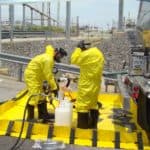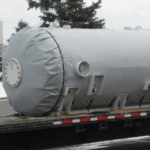Wastewater treatment plays an integral role in modern society. It ensures the safe disposal of waste and promotes sustainability by recycling water. Efficient wastewater treatment reduces our environmental impact and protects public health. State and federal agencies use the acronym WRRF, which means Water Resource Recovery Facility, to describe large-scale water recovery systems.
Did you know that the essential component of wastewater treatment is microscopic anaerobic bacteria? These bacteria break down organic matter in wastewater, converting it into methane, carbon dioxide, and other byproducts.
However, these bacteria function best at a narrow temperature range. Maintaining an optimal environment for these microorganisms requires innovative technologies like external digester heaters.
The Importance of Optimizing Anaerobic Bacteria in Wastewater Treatment
Anaerobic bacteria are indispensable to the process of wastewater treatment. In the anaerobic digestion process, they break down organic matter in the absence of oxygen. This process produces biogas, a valuable renewable energy source consisting of predominantly methane and carbon dioxide. Anaerobic sludge digestion stabilizes the solid waste, reducing its volume and making it safer for disposal.
However, the performance of anaerobic bacteria heavily relies on temperatures in a range from 68°F to 98.6°F (20°C to 37°C) in a mesophilic digester and up to 131°F (55°C) in a thermophilic digester. Any deviation from these temperatures can slow down the anaerobic digestion process, leading to less efficient waste breakdown and lower biogas production.
Challenges in Maintaining Optimal Temperatures
Although the anaerobic digestion process generates heat, it is insufficient to maintain the required temperature in colder climates.
Traditional methods of maintaining temperature, such as internal heating units or corrugated tube heat exchangers, have their limitations. Internal heating units often struggle with heat distribution, while corrugated tube heat exchangers can have issues with clogging.
These original internal heating systems often require significant maintenance and cleaning to ensure good heat transfer. System complexity leads to higher operational costs and a greater chance of system failure. The solution is to use external heat.
External Digester Heaters
External digester heaters use an external heat exchanger array to supply heat directly to the digester. They incorporate heating elements that provide consistent heating, ensuring efficient anaerobic digestion in colder conditions. Instead of relying on one heat exchanger array, these systems use multiple arrays to ensure optimal heat distribution throughout the digester.
Because the heater doesn’t come in direct contact with the wastewater, these systems are easily maintained and cleaned, reducing operational costs and improving overall system reliability.
The Advantages of External Digester Heaters
These heaters provide significant advantages over internal heaters, such as:
- Efficiency: External digester heaters provide a reliable and consistent source of heat, ensuring optimal conditions for the anaerobic digestion process.
- Easy operation: They require minimal maintenance and monitoring, allowing for precise temperature regulation. The sludge tank can remain full during routine maintenance.
- Cost-effectiveness: By efficiently heating the digester, they contribute to increased production of the biogas plant, making it a cost-effective option for energy production.
- Flexibility: These heaters offer flexibility in terms of heat transfer configurations. They can pump the sludge through external heat exchangers and return it warm to the digester.
- Improved biogas production: Maintaining the optimal temperature range increases the activity of microorganisms responsible for the breakdown of biodegradable materials. The result is increased biogas production.
These heaters retrofit onto existing digesters, making them the best custom heating solutions.
Spotlight on Custom Pipe and Tank Heaters
Custom pipe and tank heaters can accommodate different types of digesters, including aerobic sludge digesters, mesophilic and thermophilic digesters. They can manage varying flow rates and sludge densities. They provide a tailored solution for each wastewater treatment scenario.
Poweblanket specializes in custom pipe heaters. To find ideal solutions for new or replacement external digester heaters, get a custom quote or get in touch with their specialists for a consultation.
These heaters meet the specific needs of each wastewater treatment plant, ensuring optimal heat transfer and efficient operation.
Real-world Benefits of External Heaters for Sludge Digestion
There are three primary benefits of external digester heaters. They are:
Accelerates the Digestion Process – External heaters provide consistent and controlled heat, creating an ideal environment for bacterial growth. Faster and more efficient digestion results in higher biogas production and a higher volume of wastewater processing.
Energy Efficiency and Preventing Downtime – Since the heater does not contact the sludge, there is no issue of buildup or plugging of heater tubes. External heaters minimize the risk of disruption of the anaerobic digestion process and reduce the need for repairs.
Extending Bacterial and Equipment Lifespan – By keeping the digester at the optimal temperature, these heaters create a suitable environment that promotes the growth and longevity of anaerobic bacteria. External digester heaters don’t experience the added mechanical and heat stress caused by sludge buildup, prolonging their operational life.
Tailored Solutions for Wastewater Treatment
In the world of wastewater treatment, there is no one-size-fits-all solution. Each plant has its unique needs and challenges, from the type of waste treatment to the local climate conditions. This variation is why tailored solutions, like custom pipe and tank heaters, are so important.
In many cases, heating caustic soda is an essential step in the process of treating wastewater to balance the pH. Heaters can adjust to handle different types of waste, accommodate varying flow rates, and maintain optimal temperatures in different climatic conditions. This adaptability is vital to ensuring efficient and consistent anaerobic digestion.
For wastewater treatment to be a long-term solution, we must address equipment maintenance.
Installation and Maintenance of External Heaters
External heaters can attach to existing digesters without the need for major modifications to the system.
Maintenance is also simple, thanks to the accessible design of these heaters. Regular cleaning and servicing do not require significant disruption to the operation of the digester. With proper maintenance, these heaters can provide consistent and efficient heating for many years, ensuring optimal anaerobic digestion and efficient wastewater treatment.
Questions Regarding External Heat Exchangers
For those researching digesters and external heaters, here are some of the most frequently asked questions.
1. What is digester heating?
Digester heating is the process of maintaining optimal temperatures inside an anaerobic digester, typically used in wastewater treatment systems. It heats the digester to facilitate the growth and activity of anaerobic bacteria, which break down organic matter and produce biogas.
2. What are the disadvantages of using a digester?
Disadvantages of using a digester include the need for continuous maintenance and monitoring for system failures or malfunctions. There is a high risk of odor emissions, the potential for explosion, and the high energy consumption required for heating.
3. How do you heat a biogas digester?
Biogas digesters can be heated using internal or external digester heaters. These heaters provide a controlled heat source to maintain the desired temperature range within the digester. They use various energy sources, such as natural gas, electricity, or biogas.
4. How do you heat an anaerobic digester?
Anaerobic digesters can be heated using various methods, including external digester heaters and custom pipe and tank heaters. These heating systems distribute heat evenly throughout the digester, ensuring optimal growth conditions for anaerobic bacteria. The heaters use temperature sensors and automated systems to maintain the desired temperature range.
The Importance of Optimizing Anaerobic Bacteria Through External Digester Heaters
Efficient wastewater treatment protects the environment and public health. Maintaining optimal temperatures inside anaerobic digesters ensures the growth and activity of these bacteria, resulting in higher treatment efficiencies and increased biogas production.
External digester heaters offer several advantages over traditional internal heating systems, including improved thermal performance, better temperature control, and customization options.
To ensure the efficiency of your wastewater treatment process, especially in colder climates, explore custom solutions. Poweblanket’s external digester heaters maximize the performance and sustainability of your anaerobic digesters.
Frequently Asked Questions
What is digester heating?
Digester heating involves maintaining optimal temperatures within an anaerobic digester using systems like external heat exchangers to enhance the activity of anaerobic bacteria and improve biogas production.
What are the disadvantages of using a digester?
Disadvantages of using a digester include the need for continuous maintenance, potential odor emissions, risk of methane leakage, and high energy consumption for heating.
What are the three main types of digesters?
The three main types of digesters are stand-alone digesters, on-farm digesters, and digesters at wastewater treatment plants, each designed to handle specific waste processing needs.
How much does a farm digester cost?
The cost of a farm digester can range from $400 to $700 per 1,000 pounds of livestock weight, with additional costs for systems producing electricity, which can range from $800 to $1,200 per cow.
Ensuring the efficiency of your wastewater treatment process is paramount, especially in colder climates; don't let suboptimal temperatures hinder your operation's potential when tailored solutions are within reach.




